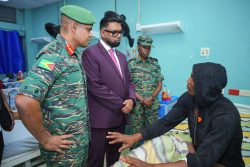-Agri Ministry says in reply to GHRA
Technical work by local and overseas engineers recommended that the East Demerara Water Conser-vancy’s (EDWC) relief channels be supplemented to avert catastrophic flooding, the Ministry of Agriculture (MoA) argued on Monday.
The Ministry was responding to a statement released earlier that day by the Guyana Human Rights Association (GHRA) calling for the Hope relief canal project to be suspended.
The ministry said that the assertions of the human rights body are completely at variance with the facts.
The MoA noted that following remedial works which strengthened the East Deme-rara Water Conservancy dam along its entire length over several years, 2005 saw a devastating flood.
Consequently, technical work undertaken by the experts recommended that the EDWC, in addition to its existing relief, must be supplemented by being drained through other means, in order to avoid catastrophic flooding.
The agency said that the National Drainage & Irrigation Authority (NDIA) developed terms of reference to satisfy the aforementioned imperative and subsequently a United Kingdom firm in collaboration with two local firms won a contract and proposed two engineering solutions to the problems associated with the area.
The two solutions, the agency noted were a high level northern relief, starting at Hope/Dochfour and ending at the Atlantic and, a Flagstaff-Mahaica Canal.
The Consultants’ Reports were reviewed by a number of experienced local engineers from the government and the private sector, the MoA noted.
The ministry stated that the Guyana Association of Pro-fessional Engineers (GAPE) was also included in the consultative process and it noted that documents were then uploaded on the internet to solicit views.
It was noted that at the commencement of Works Ceremony on the Hope Canal, Raymond Latchmansingh, Managing Director, CEMCO Incorporated Ltd, the company which was awarded the contract to carry out the consultancy for the project, indicated that “Extensive topographic survey was done by SRK, CEMCO over the last six to seven months, and the British firm Mott Mc Donald to undertake hydrological assessments of the project to do … statistic analysis to determine what flows are required to safeguard the stakeholders against the risk of flooding or overtopping of the existing conservancy.”
Emergency
solution
The release stated that the MoA emphasized, during the 2009 budget presentation, the need to relieve the EDWC and elaborated on the protocols to be followed in arriving at an emergency solution. During the ensuing debates, a series of questions on this project were answered in the nation’s highest consultative body, Parliament.
The Conservancy Adapta-tion Project is on-going but has a more limited set of objectives than those proposed by GHRA, the release noted. The MoA stated that the on-going project is aimed at aiding Guyana to adapt to climate change and focuses on a key facility, the EDWC. The US$3.8M World Bank Conservancy Adaptation Project will finance the development of the technical foundation which will strengthen the master plan of interventions within the EDWC and lowland drainage systems, as well as specific upgrading works and operational improvements aimed at enhancing the flood control capacity of the EDWC, the release stated.
Works are expected to improve the ability of the government to manage water levels behind the EDWC during heavy rainfall by improving internal flows in the EDWC. Additionally, the MoA noted, upgrading of water control structures have been undertaken including the rehabilitation of the Lama No. 1 and No. 2 sluices, restoring of the Kofi outlet and in a limited way the re-opening of the Cunha outlet into the Demerara River.
As regards the call by the GHRA for suspension of the project until a series of studies are undertaken, the MoA noted several reports, including Hydraulic Modeling of the EDWC, 2004, Task Force for Infrastructure Recovery – Flow/Discharge systems of EDWC, 2005; Guyana Floods Geotechnical and Hydraulic Assessment of East Demerara Water Conser-vancy, 2005 as well as Hydrological and Hydraulic Modeling Studies by CEMCO/SKRN in association with Mott MacDonald were considered.
The aforementioned have been supplemented by a number of other assessments, all of which have culminated in the decision go ahead with the Hope/Dochfour Canal.
Any delay in expeditiously dealing with such an imminent threat as serious floods can only result in devastating dislocation and massive disruption of the lives of thousands of citizens the ministry argued.
Following the announcement that the agreement between Norway and Guyana on the Low Carbon Development Strategy, has realized the establishment of the Guyana REDD-plus Investment Fund (GRIF), this “uninformed position of postponing debate” on climate change seems almost ludicrous, the MoA declared.
A long multi-stakeholder consultation where more than 10% of the country’s population participated directly in information sharing on the Low Carbon Development Strategy preceded this development, the ministry added.
There is no doubt that leadership at all levels: the executive, the regional, the indigenous and international have galvanized global thought on climate change, to the extent that Guyana’s Low Carbon Development Strategy is being recognized as a workable model.
Investments that are to flow “from these long and intense Low Carbon Development Strategy consultations have been delineated and have a strong nexus with climate change”, the agency stated.
The GHRA’s “insistence that for the Government it is inconvenient to discuss climate change is a massive misreading of what is clearly concrete”, the MoA contended.






